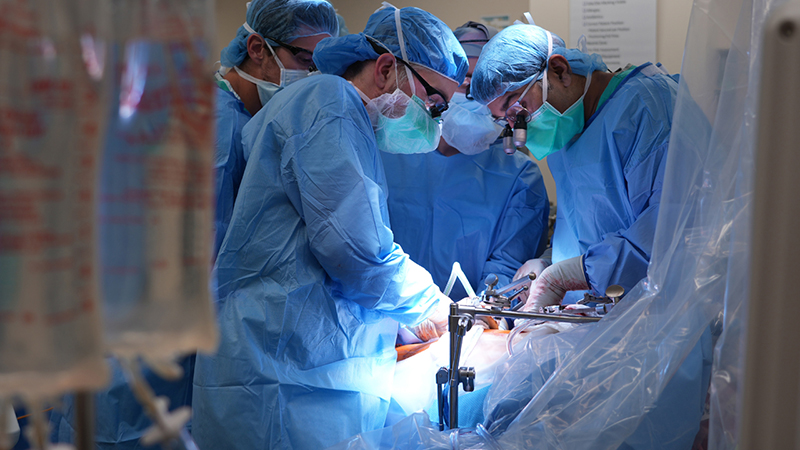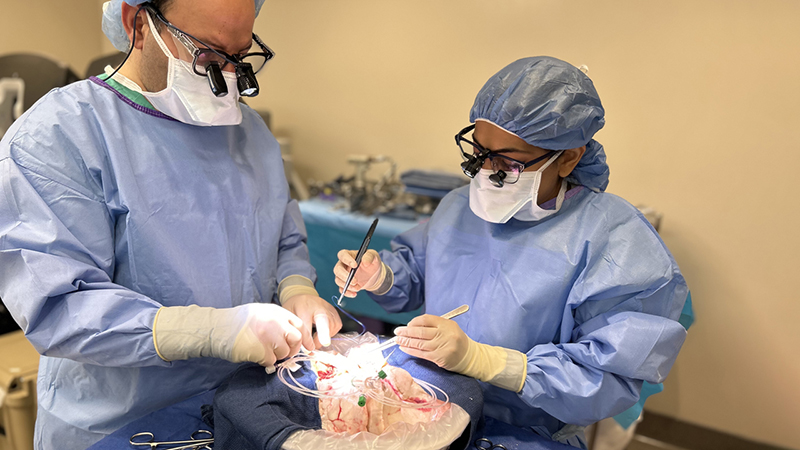Tech Innovations for Better Lung Disease Outcomes
Earlier Detection, Advanced Treatment Options
Updated October 2023
While distinct in their nature, lung cancer and chronic obstructive pulmonary disease (COPD) share some common threads. They both affect mostly people who smoke or used to smoke, reduce quality of life and can be deadly.
Fortunately, innovative technologies have emerged that offer a chance at better and faster results for patients and, ultimately, a better quality of life. These latest technologies, which are available at Northwestern Medicine, are minimally invasive and are built to expedite and enhance treatment for lung disease:
- Johnson & Johnson MedTech Ethicon Monarch™ Platform: For earlier diagnosis of lung nodules or spots on the lung that can be cancerous.
- Intuitive Ion™ robotic bronchoscopy platform: Also for earlier diagnosis of lung nodules or spots on the lung that can be cancerous.
- Pulmonx Zephyr® Endobronchial Valve system: For treatment of emphysema, a severe form of COPD.
Better Lung Biopsies
The Monarch and Ion systems are used for safer, more precise and minimally invasive biopsies (tissue samples) of spots located almost anywhere in the lung that care teams think might be cancerous. Both of these technologies allow physicians to access and collect tissue in hard-to-reach parts of the lungs that were previously inaccessible by standard biopsy. This saves valuable time to diagnosis and treatment, if needed.
We are now able to get the most information in the least invasive way.— Benjamin J. Seides, MD
“The Monarch and Ion platforms have really changed the landscape for diagnosis of lung nodules that surgeons can now get to,” says Benjamin J. Seides, MD, director of Interventional Pulmonology at Northwestern Medicine Central DuPage Hospital. “With the goal of diagnosing cancer at an earlier stage, we are now able to get the most information in the least invasive way and the shortest period of time, while also maximizing patient safety and convenience.”
How Monarch and Ion Technology Works
The Monarch and Ion platforms use a small and highly flexible and maneuverable robotic endoscope (a tube with a camera and working channel) snaked through the nose or mouth and down the throat to reach the outer edges of the lung. Once the endoscope has reached the target nodule, any number of flexible instruments can be inserted through the working channel of the endoscope to take biopsies or mark the nodule with dye or gold coils to help surgeons either remove it or direct radiation treatment to it.
Through the use of dye, the robotic platforms make it easier to locate the nodule during surgery and remove tissue only from the affected portion of the lung, preserving the surrounding healthy tissue, explains Samuel S. Kim, MD, a thoracic surgeon at Northwestern Medicine and a member of Robert H. Lurie Comprehensive Cancer Center of Northwestern University.
Better Lung Function for People With Emphysema
Zephyr Valve, an additional advanced technology for lung disease care, helps improve quality of life for patients experiencing breathlessness from emphysema. With this disease, your lung’s tiny air sacs become damaged, making it hard for the lungs to get oxygen in and carbon dioxide out. The main cause of emphysema is long exposure to irritants, such as:
- Smoke from tobacco products, including secondhand smoke
- Air pollution
- Chemical fumes
- Dust from the environment and workplace
How Zephyr Valve Technology Works
A minimally invasive, nonsurgical alternative to lung volume reduction surgery, Zephyr Valves are inserted into the airways of diseased parts of your lung. This decreases hyperinflation (when air gets trapped in the lung causing it to overinflate) and redirects air to the healthier parts of the lung. Treated patients feel less breathless and can be more active, markedly improving their quality of life.
Before this technology, the only emphysema treatment options besides inhaler therapy were highly invasive and carried significant risk.
The Bottom Line
If you suspect you are at higher risk for lung cancer or have received abnormal CT scan results, discuss screening options with your physician. If you have emphysema, talk to your physician about treatment options with the Zephyr Valve.






